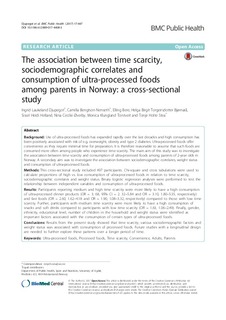| dc.contributor.author | Djupegot, Ingrid Laukeland | |
| dc.contributor.author | Nenseth, Camilla | |
| dc.contributor.author | Bere, Elling | |
| dc.contributor.author | Bjørnarå, Helga Birgit | |
| dc.contributor.author | Helland, Sissel Heidi | |
| dc.contributor.author | Øverby, Nina Cecilie | |
| dc.contributor.author | Torstveit, Monica Klungland | |
| dc.contributor.author | Stea, Tonje Holte | |
| dc.date.accessioned | 2018-01-16T09:15:04Z | |
| dc.date.available | 2018-01-16T09:15:04Z | |
| dc.date.created | 2017-06-14T12:09:43Z | |
| dc.date.issued | 2017 | |
| dc.identifier.citation | Djupegot et al. BMC Public Health (2017) 17:447 | nb_NO |
| dc.identifier.issn | 1471-2458 | |
| dc.identifier.uri | http://hdl.handle.net/11250/2477724 | |
| dc.description.abstract | Background: Use of ultra-processed foods has expanded rapidly over the last decades and high consumption has been positively associated with risk of e.g. overweight, obesity and type 2 diabetes. Ultra-processed foods offer convenience as they require minimal time for preparation. It is therefore reasonable to assume that such foods are consumed more often among people who experience time scarcity. The main aim of this study was to investigate the association between time scarcity and consumption of ultra-processed foods among parents of 2-year olds in Norway. A secondary aim was to investigate the association between sociodemographic correlates, weight status and consumption of ultra-processed foods.
Methods: This cross-sectional study included 497 participants. Chi-square and cross tabulations were used to calculate proportions of high vs. low consumption of ultra-processed foods in relation to time scarcity, sociodemographic correlates and weight status. Binary logistic regression analyses were performed to test the relationship between independent variables and consumption of ultra-processed foods.
Results: Participants reporting medium and high time scarcity were more likely to have a high consumption of ultra-processed dinner products (OR = 3. 68, 95% CI = 2. 32–5.84 and OR = 3.10, 1.80–5.35, respectively) and fast foods (OR = 2.60, 1.62–4.18 and OR = 1.90, 1.08–3.32, respectively) compared to those with low time scarcity. Further, participants with medium time scarcity were more likely to have a high consumption of snacks and soft drinks compared to participants with low time scarcity (OR = 1.63, 1.06–2.49). Finally, gender, ethnicity, educational level, number of children in the household and weight status were identified as important factors associated with the consumption of certain types of ultra-processed foods.
Conclusions: Results from the present study showed that time scarcity, various sociodemographic factors and weight status was associated with consumption of processed foods. Future studies with a longitudinal design are needed to further explore these patterns over a longer period of time.
Keywords: Ultra-processed foods, Processed foods, Time scarcity, Convenience, Adults, Parents | nb_NO |
| dc.language.iso | eng | nb_NO |
| dc.publisher | Biomed Central | nb_NO |
| dc.rights | Navngivelse 4.0 Internasjonal | * |
| dc.rights.uri | http://creativecommons.org/licenses/by/4.0/deed.no | * |
| dc.title | The association between time scarcity, sociodemographic correlates and consumption of ultra-processed foods among parents in Norway: a cross-sectional study | nb_NO |
| dc.type | Journal article | nb_NO |
| dc.type | Peer reviewed | nb_NO |
| dc.description.version | publishedVersion | nb_NO |
| dc.source.pagenumber | 1-8 | nb_NO |
| dc.source.volume | 17 | nb_NO |
| dc.source.journal | BMC Public Health | nb_NO |
| dc.source.issue | 1 | nb_NO |
| dc.identifier.doi | 10.1186/s12889-017-4408-3 | |
| dc.identifier.cristin | 1475999 | |
| dc.description.localcode | nivå1 | |
| cristin.unitcode | 201,18,2,0 | |
| cristin.unitname | Institutt for folkehelse, idrett og ernæring | |
| cristin.ispublished | true | |
| cristin.fulltext | original | |
| cristin.qualitycode | 1 | |

